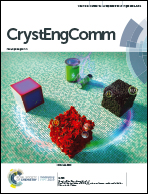A two-fold 3D interpenetrating cyanido-bridged network based on the octa-coordinated [Mo(CN)8]4− building block†
Abstract
Complex [Ni(cyclam)]2+ and [Mo(CN)8]4− building blocks were used to construct three coordination networks differing in dimensionality and topology. The 3D {[Ni(cyclam)]2[Mo(CN)8]·16H2O}n (1) network obtained by slow diffusion of a water–ethanol mixture shows a diamond-like topology with a net of intersecting water-filled channels. The synthesis carried out in LiCl water solution leads to the 2D {Li2[Ni(cyclam)]3[Mo(CN)8]2·24H2O}n (2) network of honeycomb-like topology with Li+ cations and crystallisation water trapped in the parallel microporous channels of the structure. Additional heating of the reaction mixture results in the 2-fold interpenetrating 3D {[Ni(cyclam)]5[Ni(CN)4][Mo(CN)8]2·10H2O}n (3) network, containing the additional [Ni(CN)4]2− anionic building block formed in situ through partial decomposition of the starting complexes. Compound 3 consisting of two identical frameworks of diamond-like topology is a unique example of interpenetration in the family of octacyanidometallate-based assemblies. Compounds 2 and 3 undergo reversible dehydration as confirmed by dynamic vapour sorption studies and show paramagnetic behaviour arising from the presence of octahedral Ni(II) cationic complexes separated by diamagnetic [Mo(CN)8]4− and [Ni(CN)4]2− ions.
![Graphical abstract: A two-fold 3D interpenetrating cyanido-bridged network based on the octa-coordinated [Mo(CN)8]4− building block](/en/Image/Get?imageInfo.ImageType=GA&imageInfo.ImageIdentifier.ManuscriptID=C9CE00851A&imageInfo.ImageIdentifier.Year=2019)


 Please wait while we load your content...
Please wait while we load your content...